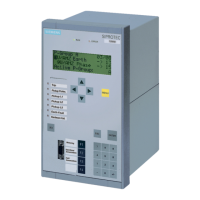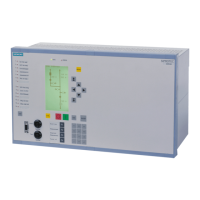Further figures show examples for the additional connection of a different voltage, in this case the busbar
voltage (e.g. for voltage protection or synchronism check). For the voltage protection the address 210 U4
transformer = Ux transformer has to be set, U4 transformer = Usy2 transf. for the synchronism
check. The address 215 Usy1/Usy2 ratio is only then not equal to 1 when feeder transformer and busbar
transformer have a different transformation ratio. .
If there is a power transformer between the set of busbar voltage transformers and the set of feeder voltage
transformers, the phase displacement of the voltage caused by the power transformer must be compensated
for the synchronism check if used. In this case also check the addresses 212 Usy2 connection, 214 φ
Usy2-Usy1 and 215 Usy1/Usy2 ratio. You will find detailed notes and an example in Section
2.1.3.1 Setting Notes under “Voltage connection”.
Binary Inputs and Outputs
The connections to the power plant depend on the possible allocation of the binary inputs and outputs, i.e.
how they are assigned to the power equipment. The preset allocation can be found in the tables in Section
D Default Settings and Protocol-dependent Functions of the Appendix. Check also whether the labelling corre-
sponds to the allocated indication functions.
Changing Setting Group
If binary inputs are used to change setting groups, please observe the following:
•
To enable the control of 4 possible setting groups 2 binary inputs have to be available. One binary input
must be set for
>Set Group Bit0
, the other input for
>Set Group Bit1
.
•
To control two setting groups, one binary input set for
>Set Group Bit0
is sufficient since the binary
input
>Set Group Bit1
“, which is not assigned, is considered to be not controlled.
•
The status of the signals controlling the binary inputs to activate a particular setting group must remain
constant as long as that particular group is to remain active.
The following Table shows the relationship between binary inputs and the setting groups A to D. Principal
connection diagrams for the two binary inputs are illustrated in the following figure. The Figure illustrates an
example in which both Set Group Bits 0 and 1 are configured to be controlled (actuated) when the associated
binary input is energized (high).
Table 3-1
Changing setting groups with binary inputs
Binary Input Active settings group
>Set Group Bit 0 >Set Group Bit 1
Not energized Not energized GroupA
Energized Not energized Group B
Not energized Energized Group C
Energized Energized Group D
[einstellgruppenumschalt-7sa-ueber-binaere-240702-kn, 1, en_GB]
Figure 3-1 Connection diagram (example) for setting group switching with binary inputs
Mounting and Commissioning
3.1 Mounting and Connections
SIPROTEC 4, 7VK61, Manual 179
C53000-G1176-C159-5, Edition 05.2018

